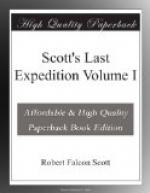The numbers are Statute Miles.
Marches
Out Return Lower Glacier to Southern Barrier Depot 5 6 1/2 Southern Barrier to Mid Barrier Depot 5 1/2 6 1/2 Mid Barrier to Mount Hooper 4 3/4 8 Thereafter 4 8
It will be noted that of the first 15 Return Marches on the Barrier, 5 are 11 1/2 miles and upwards, and 5 are 8 1/2 to 10.
NOTES
[1] It was continued a night and a day.
[2] Captain Oates’ nickname.
[3] A species of shrimp on which the seabirds feed.
[4] The party headed by Lieutenant Campbell, which, being unable to disembark on King Edward’s Land, was ultimately taken by the Terra Nova to the north part of Victoria Land, and so came to be known as the Northern Party. The Western Party here mentioned includes all who had their base at Cape Evans: the depots to be laid were for the subsequent expedition to the Pole.
[5] The extreme S. point of the Island, a dozen miles farther, on one of whose minor headlands, Hut Point, stood the Discovery hut.
[6] Here were the meteorological instruments.
[7] Cape Evans, which lay on the S. side of the new hut.
[8] The Southern Road was the one feasible line of communication between the new station at C. Evans and the Discovery hut at Hut Point, for the rugged mountains and crevassed ice slopes of Ross Island forbade a passage by land. The ‘road’ afforded level going below the cliffs of the ice-foot, except where disturbed by the descending glacier, and there it was necessary to cross the body of the glacier itself. It consisted of the more enduring ice in the bays and the sea-ice along the coast, which only stayed fast for the season.
Thus it was of the utmost importance to get safely over the precarious part of the ‘road’ before the seasonal going-out of the sea-ice. To wait until all the ice should go out and enable the ship to sail to Hut Point would have meant long uncertainty and delay. As it happened, the Road broke up the day after the party had gone by.
[9] Viz. Atkinson and Crean, who were left at Safety Camp; E. Evans, Forde and Keohane, who returned with the weaker ponies on Feb. 13; Meares and Wilson with the dog teams; and Scott, Bowers, Oates, Cherry-Garrard, and Lashly.
[10] The favorite nickname for Bowers.
[11] Professor T. Edgeworth David, C.M.G., F.R.S., of Sydney University, who was the geologist to Shackleton’s party.
[12] This was done in order to measure on the next visit the results of wind and snow.
[13] Scott, Wilson, Meares and Cherry-Garrard now went back swiftly with the dog teams, to look after the return parties at Safety Camp. Having found all satisfactory, Scott left Wilson and Meares there with the dogs, and marched back with the rest to Corner Camp, taking more stores to the depot and hoping to meet Bowers rearguard party.




